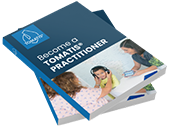DIR Floortime®: How Tomatis® Complements It
Are you a dedicated DIR Floortime® Therapist? Are you committed to enhancing your practice and helping your clients achieve their desired outcomes more effectively? If so, consider the opportunity to expand your toolkit with the Tomatis® Method – a powerful and breakthrough tool that can seamlessly complement the DIR approach. The DIR/Floortime® Certification is undoubtedly a valuable foundation for supporting individuals with developmental challenges. However, by incorporating the Tomatis® Method into your therapeutic repertoire, you can help clients reach their true potential. Tomatis® is known for its innovative approach to auditory-sensory processing, and offers a unique and powerful way to accelerate your clients' progress.

Here is just the Toolkit your need for Breakthroughs
DIR Floortime Training Certification
The DIR Floortime® (DIR or Floortime) is a developmental and relationship-based intervention that emphasizes engaging with individuals based on their individual differences and developmental level. It focuses on building emotional connections, promoting social engagement, and fostering cognitive and emotional growth through interactive play and relationship-building activities.
How can you use Tomatis® as a complement to DIR Floortime?
The Developmental, Individual-difference, Relationship-based (DIR) model focuses on understanding and supporting an individual’s unique developmental level, personal differences, and capacity for relationships. Implementing the Tomatis Method initially can significantly enhance a person’s sensory awareness, attunement, and self-regulation, creating an ideal state for engaging in DIR-based interventions. While applying DIR techniques, especially with children, it’s beneficial to integrate listening sessions, allowing for a responsive approach that respects the child’s cues—offering support for listening, encouraging interaction as desired, and providing regulation assistance during moments of overwhelm.
Enhancing Outcomes: The synergy of Tomatis® and DIR Floortime
The Tomatis® Method helps accelerate the results that one can obtain from DIRFloortime® by restoring the link that connects the brain, the ear, and the voice. Here are a few benefits (but not limited to) of using Tomatis® in conjunction with DIRFloortime®:
Auditory Processing
Using the Tomatis® Method to improve foundational auditory processing skills prepares individuals for more effective Floortime sessions. Tomatis® enhances sensory integration and auditory perception, enabling better navigation of sensory experiences, and making them more receptive during Floortime. This strengthened foundation supports the development and engagement promoted by the DIR/Floortime approach.
Sensory Integration
The Tomatis® Method enhances sensory integration skills by targeting the auditory system. This improvement in sensory integration can lead to better regulation, enabling individuals to cope more effectively with the sensory challenges of new and different environments. Consequently, being in a well-regulated state enhances individuals' readiness during their DIRFloortime sessions, reducing the need for additional sensory support.
Attention and Engagement
The Tomatis® Method aims to increase attention and engagement by improving auditory processing and promoting active listening, which can positively impact the individual's ability to participate in DIR/Floortime® activities.
The Tomatis® Method focuses on improving attention and awareness of the world around us, thereby enabling individuals to be more engaged and connected. The foundation of DIR/Floortime is to assist individuals in enhancing their ability to engage and connect, making these two approaches a perfect pairing.
Communication Skills
By enhancing auditory perception and discrimination, Tomatis® can contribute to the development of speech and language skills, supporting effective communication during DIRFloortime® interactions.
Anxiety and Emotional regulation
The Tomatis® Method can assist individuals in regulating their emotions by promoting a sense of calm and diminishing hypersensitivity to sound. This, in turn, can facilitate emotional engagement and regulation during DIR/Floortime® sessions.
Social Interactions
Improved auditory processing through the Tomatis® Method can positively influence social interaction skills, such as turn-taking, joint attention, and reciprocal communication, all of which are crucial aspects of DIRFloortime®.
The power of combining Tomatis® Method and DIRFloortime® in Therapy
The fusion of the Tomatis® Method and DIRFloortime® yields a potent combination, catering to the intricate needs of children with developmental disabilities. While DIRFloortime® focuses on facilitating emotional and social growth through relationship-centered interventions, the Tomatis® Method specializes in refining auditory processing and sensory integration skills. By mitigating hypersensitivity to sounds and refining auditory processing, the Tomatis Method lays the groundwork for enhanced sensory integration. As individuals progress in these areas, they gain better emotional regulation and a heightened sense of security.
When we feel secure and regulated, we become more open to engaging with others—a principle at the heart of DIR/Floortime methodology. Through this synergistic blend, the strengths of each approach support one another, resulting in profound and lasting transformations for clients. Together, the Tomatis Method and DIRFloortime® not only facilitate improved outcomes but also instill enduring and meaningful changes in individuals’ lives.
Start your journey and request your free „How to become a Tomatis® Practitioner“ documentation
Containing all the necessary details to commence your Tomatis® training as soon as possible
- The Tomatis® Method explained in details and its application to sensory and auditory processing disorders
- Its unique and unparalleled technology at your service
- The 7 areas of application for which the Method gets results
- The richness of its community of 3000 therapists around the world with whom you can interact and obtain support
- Advice on how to propose the Method to your clients and integrate it into your protocols
- All the modalities and programs to train in the Method and become a practitioner.
Ask your free documentation
only intended for professionals



